Electric Vehicles (EVs)
Reasonably Priced Hybrid Vehicles (A-H)
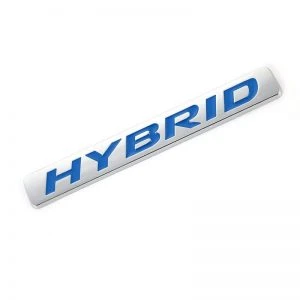
In-between stages can sometimes get tricky. The next set of sit-ups before truly hitting your peak fitness regime. That gap year before study, or the six months prior to the new job contract starting. What about the EV world? We’re not capable of running a full fleet of EV cars yet, but maybe there’s an in-between vehicle that ticks all the right boxes before we go fully electric.
The truth is that the new hybrid vehicles are the best cars for this moment in time. They deliver the very best low fuel consumption figures and will also try to run pure electric as much of the time as is practical or possible.
Hybrids are great vehicles, usually well-priced, thus perfect for softening the blow to the wallet – there are some hideously expensive EVs available. Most desirable new EVs have price tags that, for most of us, will be well beyond our budget. So what hybrid vehicles are on the market for reasonable money? How much will they set you back when you buy new? And what sort of fuel consumption can you expect? Let’s have a look and see…
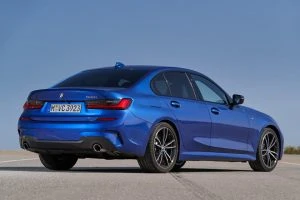
BMW 330e Sedan Hybrid Sedan
Drive away from around $85k in your new BMW 330e Hybrid sedan, where a claimed combined fuel consumption of around 5.6 litres/100 km combined with 215 kW provides plenty of spirited driving (0-100 km/h in around 6 seconds). Comfort, safety and all the new technology is on-board this neat 3 Series Hybrid Sedan package. 375 litres of boot space is present.
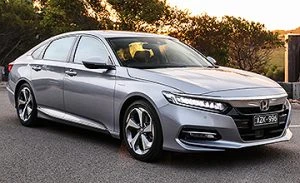
Honda Accord VTi-LX Hybrid Sedan
Drive away in a new Honda Accord Hybrid for around $61k, and you get a wonderful 2.0-litre petrol and electronic combo that serves up 158 kW of power running through a 1-speed CVT FWD set-up. This is a very comfortable car with plenty of space in the cabin, and you get all the latest technology and safety. It is fun to drive, with the 0-100 km/h sprint taking around 8 seconds. Honda indicates that you can expect around 5.0 litres/100 km for a combined fuel consumption figure. 473 litres of boot space is present.

Honda HR-V e:HEV L
Wanting a new small SUV with Hybrid technology? Then Honda’s little HR-V is a beauty. Drive away in a new Honda HR-V e from around $45k, and it will boast a smooth 1.5-litre petrol and electronic combo that serves up 96 kW of power running through a 1-speed CVT FWD set-up. Honda suggests we can expect a combined fuel consumption of around 4.3 litres/100 km. 319 litres of boot space is present.
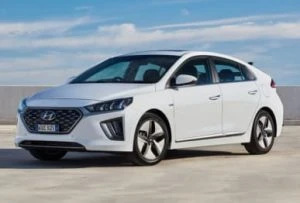
Hyundai IONIQ Hybrid Premium Fastback
Drive away from around $46k. With its neat little Fastback design, the 1.6-litre ULP engine combines with a small electric motor to put out a sprightly 104 kW of power. This Hybrid set-up runs a more conventional 6-speed automatic FWD, and it is a smooth, comfortable vehicle to drive. Undercutting competitors such as the Toyota Prius and Renault Zoe, Hyundai’s IONIQ comes with plenty of premium features like autonomous emergency braking, an 8-year battery warranty and an attractive capped-price servicing deal. The regular hybrid version is quoted at having a fuel consumption figure as low as 3.4 litres/100 km, while the plug-in version was quoted at an astonishing 1.1 litres/100 km. Real world figures will be a bit more, I’m sure, but. Boot space is 443 litres.
Be an in-betweener and gain some of the benefits. Take a look at the next blog list of Hybrid vehicles available (Kia-Merc).
Top 10 New Vehicles Sold March 2022

There are still a reasonable number of new cars being sold in Australia, when you can get them! For the second year running, new car sales figures have been heavily impacted by the COVID-19 pandemic. While the 2020 lockdowns stopped production and prevented sales, in 2021 it was really the global supply chain problems that caused the biggest headaches for ensuring manufacturers had all the bits to make up an entire car to sell. Most notably, it was the availability of semiconductors that caused the greatest complications, even to the point where all car manufacturers – it didn’t matter what brand – had to halt their production lines at various times.
Consumers have seen this effect playing out with the low stock of new cars at dealerships across the country, as well as much higher prices for used vehicles. Getting a handle on the new cars that people have actually bought has been tricky at times, but we can now give you an update on the 10 best-selling cars in Australia for the March 2022 sales results.
While the Toyota Hilux still keeps its position as Australia’s best-selling new car (and favourite ute overall), overall new car sales for March 2022 have stayed relatively stable across the board and across Australia. Data from the Federal Chamber of Automotive Industries (FCAI) has unveiled an overall monthly sale of 101,233 units for new vehicle sales across Australia for March. That’s still a fair few!
Several favourite vehicles remain at the top of the list, including 4 Toyota models (Hilux, RAV4, Prado and Corolla) making the top 10. An interesting bump in sales was seen with the number of Tesla Model 3 cars being sold. There were enough Tesla Model 3 sales to see it being Australia’s best-selling electric vehicle (EV) brand as well as making the top 10.
Australia’s top 10 best-selling cars for March 2022 were:
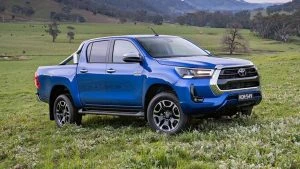
Number 1, Toyota Hilux

Number 2, Toyota RAV4

Number 3, Mitsubishi Triton
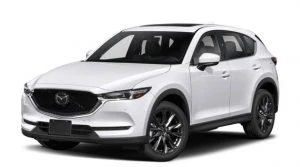
Number 4, Mazda CX-5
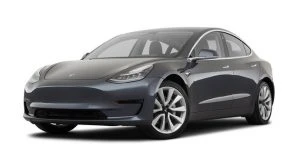
Number 5, Tesla Model 3
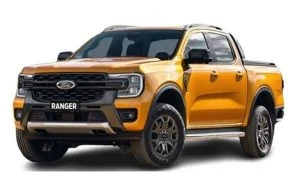
Number 6, Ford Ranger
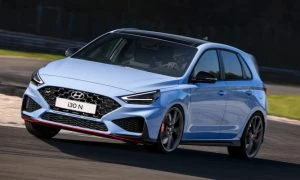
Number 7, Hyundai i30
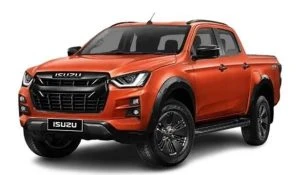
Number 8, Isuzu D Max
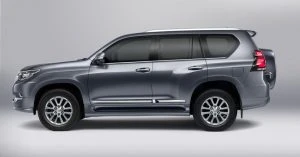
Number 9, Toyota Prado
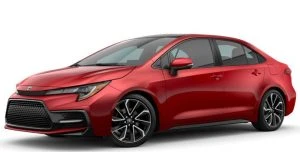
Number 10, Toyota Corolla
Consumer inquiries and demand for new cars remains strong in Australia, though manufacturers are working hard to match this demand with the actual supply of products, particularly as they continue to recover from all the COVID-19 upheaval and shutdowns and the ongoing global semiconductor shortage.
FCAI Chief Executive Tony Weber suggests that Australians are purchasing vehicles with zero- and low-emissions in greater numbers. This purchasing also includes more hybrid vehicles being sold.
Solid-State Batteries for EVs

The flourish of new electric vehicles (EVs) and hybrids on the auto markets hint towards the diminishing of fossil fuel use. EV sales have a long, long way to go before outselling vehicles with internal combustion engines (ICEs), but the goals have been set by international emission standard agreements. Certainly, doing away with EV range anxiety, the liquid lithium-ion batteries proneness to catching fire, having EVs with brief recharging times that are in line with current ICE refuelling times, and have pricing parity between a new EV and an equivalent new ICE vehicle would make a world of difference in the minds of people on the lookout for a new car. Once these EV problems have been solved, perhaps consumers will genuinely buy into an all-EV future.
The good news for EV enthusiasts is that essentially every big automotive manufacturer in the world has unveiled its fleet’s electrification plans and zero-emission target dates. Some manufacturers have even gone further, declaring that gasoline and diesel engines would no longer be available in their model line-ups by 2050. And, in order for these claims to become reality, some big landmark advancements in the EV future are being made right now, with huge money currently being pumped into various manufacturer’s kitties to research and create the perfect solid-state battery – especially designed for use in EVs.
One automotive manufacturer with a big sway in what goes down in the automotive world is Toyota, and they have pumped billions into creating a solid-state battery for use in their future hybrid vehicles and EVs. A version of Toyota’s LQ Concept, which first debuted at the 2019 Tokyo Motor Show, is now using working solid-state batteries, and has been doing so since June 2020. Toyota has been collecting all the performance data from the solid state batteries in the LQ for research, development, and better solid-state battery designs. The LQ Concept car is unlikely to end up as a production vehicle, however the solid-state batteries inside the car, and their development, will be used as a blueprint in Toyota’s new hybrid vehicles and EVs soon to make an appearance on the market for buyers to purchase.
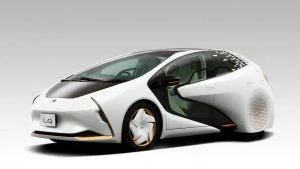
Toyota LQ Concept Solid-State
Toyota’s quick development of solid-state batteries for use in all their hybrid and electric vehicles by 2030 is a sign of the ramping up in EV production that is happening not only at Toyota but in all other big global automotive brands who are boosting investments in the anticipation of greater EV and hybrid vehicle consumerism.
What battery type does Tesla use? Currently, Tesla has been using heavy liquid lithium-ion battery technology. However solid-state batteries are really the next step in clever battery technology, especially for EVs. Why? Solid-state batteries offer much better energy density, which leads to smaller, lighter batteries for cars but with a vastly improved range before recharging is necessary. Solid-state batteries will also be able to recharge from empty (flat) to 80 % in just 15 min – not anywhere between 2 to 10 hours that is currently the norm, if you can find a spare fast charger to park up at.
The good news for solid-state batteries doesn’t stop here either, because solid-state batteries are inherently safer due to the lack of flammable liquid electrolytes that you’ll find in liquid lithium-ion batteries. You may have heard of various electronic devices bursting into flame? Well, liquid lithium-ion batteries bursting into flame and causing fires in various EVs over the last couple of decades has been an issue. This in itself has deterred many people away from buying into EVs altogether.
So, big dollars are being spent in the design of solid electrolyte batteries (solid-state batteries) that are stable, chemically inert, and still a good conductor of ions between the electrodes. In essence solid-state batteries will be doing away with the slopping, flammable liquid lithium-ion electrolyte battery designs.
By default, solid-state batteries are more stable, but they are also more compact in design, and therefore lighter. Solid state batteries thus pack more energy output into the same amount of storage space that heavier and lower-output liquid lithium-ion batteries require. Because solid-state batteries are lighter, they have more energy density, offer more range, and deliver a better power to weight ratio, and they also recharge faster.
Solid-state batteries have been used in small electronic devices like pacemakers (an amazing bit of life-changing tech) as well as radio frequency identification (RFID), and wearable devices for years. Having fewer bits and pieces involved in the solid-state battery design means fewer things are present to go wrong. In addition to their improved safety, size, and stability, solid-state batteries in EVs would also offer faster charging times, more travel range, and even greater energy density.
Solid electrolytes in solid-state batteries can even be composed from a number of everyday materials – even ceramics and glass. The challenge to making solid-state batteries viable, however, is developing the technology that is commonly used in small devices and applying it to large-scale applications like in an EV. Currently, solid state batteries are expensive to fabricate because they have been prone to cracking, which has been a result of the brittleness of the electrolytes inside the battery expanding and contracting during continual use. The new research and development is setting out to change this.
Toyota is cracking the problem and will be using their solid-state batteries in their new range of hybrid vehicles first, which is an ideal testing ground for their fully-kitted EVs soon. Volkswagen is also promising that they will have solid-state batteries in use and in their cars by 2024. Like Toyota and Volkswagen, BMW anticipates that solid-state batteries could make it into production cars by 2025. Tech giants Samsung and Panasonic are working away at creating a range of solid state batteries that automakers will be able to use. Toyota has partnered with Panasonic to pave the way to an EV future.
Lightyear One – a Solar Powered EV

Lightyear One – a Solar Powered EV
In a country like Australia where the sun shines brightly for most of the year a car like the Lightyear One might be just the thing for getting around in. Sleek and comfortable, the Lightyear One is a solar-powered electric vehicle (EV) that has been designed and engineered in the Netherlands by Lightyear.
Having been recently tested in Italy, the Lightyear One completed 400 km on a single charge while driving at a constant speed of 130 km/h. According to Lightyear One’s manufacturer, regular driving will easily result in a range of 725 km (WLTP). If you’re like me and don’t know what WLTP means, then WLTP stands for Worldwide Harmonized Light-Duty Test Procedure. This mouthful is a new standard to measure fuel consumption, CO2 emissions, and range. The standard was introduced in 2017 and takes the measurements of test vehicles when driven in realistic driving situations to determine their fuel consumption, range, and emissions.
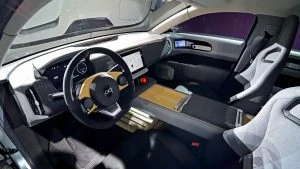
Lightyear One Interior
Because the Lightyear One is a solar-powered EV, its manufacturer also states that it would be possible to drive the car for months without needing to recharge. In Australia, where the sun shines most days of the year, a car like the Lightyear One would be perfect for this scenario. Take a good look at the car’s exterior and you’ll see the array of solar panels incorporated into the sleek exterior design. All of the panels facing skyward are made of solar panels and are ready for harvesting energy from the sun to charge the 60 kWh battery. 5 m2 of solar panels cover the Lightyear One’s roof, bonnet and tail and are capable of harnessing up to 12 km of range every hour. That means during a sunny 8-hour workday, a parked up Lightyear One could harvest 96 km of driving range – more than enough for most people’s work commutes. Even in cloudy conditions, its maker claims the Lightyear One that around 40 km of range can be harvested in that time. Obviously, you can also plug the car in for a quick recharge if you ever needed to.
Jump in the Lightyear One and drive on a full charge, and the Lightyear One’s 60 kWh battery pack provides a claimed 725 km of range, making it one of the most energy efficient EVs on the market. Efficiency of this standard is also achieved thanks to its construction consisting essentially of aluminium and carbon-fibre which gives it a weight of just 1315 kg. Also the car’s drag coefficient of just 0.20cd is sensational. As you can imagine, the aluminium and carbo-fibre underpinnings also drive the price of the car upward.
The Lightyear One is being manufactured in Finland, where its first deliveries will be made to Europe in mid-2022. The car’s price is around the AUD $238,000 mark. Just 946 of these cars will be built, however the company is already working on a more affordable solar-powered EV called the Lightyear Two which is expected to go on sale in 2024/25. It will have a much more affordable price, maybe even as low as AUD $50,000.
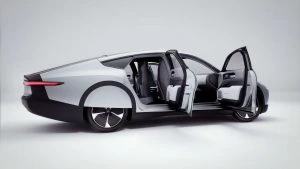
Lightyear One Sedan
In the Lightyear One there are 4 electric motors on board, one for each wheel. These provide the driving power. Together, they produce a combined 101 kW of power and 1200 Nm of torque. The car’s manufacturers say that the Lightyear One Sedan can seat 5 in comfort, and it has been designed especially for cruising and efficiency, and not for outright speed, thus claiming a 0-100 km/h sprint time of around 10 seconds.
I hope we see cars like this become available to people in Australia very soon. It also begs the question: Couldn’t the Holden name resurrect itself by Holden designers and engineers making a similar type of car in Australia for primarily Australians?